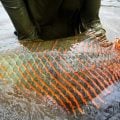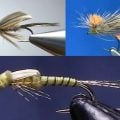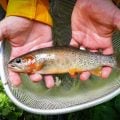How to Tie Koga’s Bonefish Shrimp
Producer: Tim Flagler
This yummy looking shrimp pattern is Peter Koga’s Bonefish Shrimp. Born in Maui, Peter now calls southern California home. His fishing career has included a trout phase, a steelhead phase and now a sight-fishing for bonefish phase. A gifted tier, he’s a fixture at fly fishing and tying shows throughout the country, yet still manages to regularly sneak off to Hawaii and elsewhere to chase bonefish on the flats. So, here you go, Peter Koga tying Koga’s Bonefish Shrimp.
Peter begins with a Gamakatsu SL11-3H hook. After getting the hook firmly secured in the jaws of his tying vise, he loads a bobbin with a spool of UTC 140 Denier tan thread. Start your thread on the hook shank above the point and take wraps rearward to the start of the bend, and then back forward to build up a foundation for the bead chain eyes, which will be tied in next. You can then snip the excess tag off close.
Medium sized gold bead chain eyes are used to weight the fly. Secure them to the top of the hook shank with cross wraps and under wraps or whatever you need to get them really locked down and perpendicular to the hook shank. Once you’ve got them secured, do a whip finish and snip your tying thread free. Make absolutely sure the eyes are level, in other words, parallel to the surface of your tying table.
Reload your bobbin, this time with Veevus 8/0 Pink thread and secure it to the hook shank in back of the bead chain eyes. Continue taking wraps about 1/3 of the way down the bend of the hook before snipping the excess tag off close.
Separate a single strand of McFly Foam from the bundle, the color used here is called “Early Girl”. Lay one end of the strand on top of the hook shank slightly down the bend and take thread wraps to secure it. Continue taking wraps to bind it down really well, all the way up to the bead chain eyes. When you’re done, snip the excess McFly Foam off close. Clean up the tie-in area with a few more thread wraps and then snip the McFly Foam off square, so it’s even with the back edge of the hook bend. Relocate your tying thread to about halfway between the hook point and the barb.
Tan Loco Legs are used to represent the long walking legs of the shrimp. Cut 2 strands free from the rest. Lay one end of the 2 strands against the near side of the hook and take thread wraps to secure it. Use only mild tension on the very back wraps to channel the legs rearward, rather than having them splay outward as they would with tight wraps. Up near the eyes, the wraps can be tighter. Bring the opposite ends of the Loco Legs around to the far side of the hook to form a loop and snip their ends off even and square, before securing them to the far side of the hook in the same manner as you did on the near side. Then, invert the hook in your tying vise or, if you have a rotary vise, give it a 180 degree turn. Snip the loop end of the legs off so you’re left with 4 legs, all about a hook shank and a half in length.
Mono eyes add a significant amount of realism to the pattern, you can purchase them pre-made or make your own. Use a small pair of needle-nosed pliers to flatten a section of the mono, about 1/4” down from the eye. Doing this makes tie-in much easier. Then, with the mono still held firmly in your pliers, bend the eye segment so it cants slightly upward. This will cause the eyes to splay outward once they’re tied in. Repeat the same process on the second mono eye. With your hook still inverted, lay the flattened part of the mono of one eye against the near side of the hook and take thread wraps to secure it. You want the eye to be angled gently upward relative to the hook’s inverted orientation. Rotating your vise or flipping the hook again will make tying in the second eye much easier as that will now be done on the near side of the hook. Keep taking thread wraps to make sure everything is secured and fairly smooth. You can then reach in and snip the excess mono eye stalks off close, nail clippers work especially well for this task. Take wraps of tying thread to cover up the remaining exposed butt ends of the mono. End with your tying thread at about the barb and then, as before, invert the hook.
A single strand of Senyo’s Barred Predator Wrap is used to add detail and realism to the pattern. Fold the strand at its midpoint around your tying thread and take thread wraps to secure it to the underside of the hook shank. Separate the resultant two strands so one is on either side of the hook.
Flat pearl diamond braid is used to create the body of the fly, a 10” length should be more than enough. With the hook positioned in your tying vise like so, secure one end of the braid to the underside of the hook shank and pull it rearward to the correct length, so there’s no trimming involved. Then, advance your tying thread forward, leaving a small space behind the eye. Keep on taking wraps with your tying thread to build up a pink underbody over which the braid will be wrapped. End with your tying thread just behind the hook eye. Get hold of the braid and start making wraps with it forward, including a cross wrap to cover up the intersection of the bead chain and the hook. Continue taking slightly overlapping wraps with the braid forward, all the way up to your tying thread. You can then use the thread to secure the braid directly to the hook shank. Next, making sure your thread is well out of the way, reach in with your tying scissors and snip the excess braid off close.
Natural colored coyote premium wing fur is used to represent the shrimp’s shell-like carapace and abdomen. Cut a small clump free from the hide and strip out the fluffy underfur leaving only the well-marked guard hairs. Measure so the tips of the hair extend about a hook gap length behind the eyes, and trim off the butt ends of the hair accordingly. Place these butt ends on the underside of the hook shank at the tie-in point and take tight wraps of tying thread to secure it. The tight wraps should cause the hair to cant slightly upward, so it obscures much of the hook bend and the point. Although not essential, a dozen or so black tipped guard hairs snipped from an Arctic Fox tail or similarly marked fur, will add nicely to the pattern. Tie in the butt ends of the hair as you did the coyote and take ample thread wraps to cover them well. The tips of these guard hairs should extend a fair bit further than the tips of the coyote hair.
Krystal Flash in Bonefish Tan is used to add a little sparkle to the carapace. Pull 2 strands through the ever-so-clever clipped corner of the packet and snip them free. Place one end of the material against the near side of the hook so the tips extend rearward just past the eyes. Take a few thread wraps to secure both strands. Loop the Krystal Flash under the shank, behind the eye, and up to the far side of the hook. Once it’s there, take thread wraps to anchor it. Pull those strands rearward and pin them down with wraps of tying thread. You can then snip them off close so they’re the same length as the strands on the near side of the hook. This basically completes the tying portion of the fly so do a 3 or 4 turn whip finish to secure your tying thread, seat the knot really well and then snip your tying thread free. A thin coat of UV cure resin applied to the thread wraps will make sure nothing pulls out or comes unraveled and adds a little bit of shine to the head of the fly.
Peter has personally tested and had success with this pattern on bonefish flats from the Bahamas to Hawaii. It’s a tough job but someone’s gotta do it.
How to Tie Koga's Hula Charlie
How to Tie Kurt's Creek Minnow











